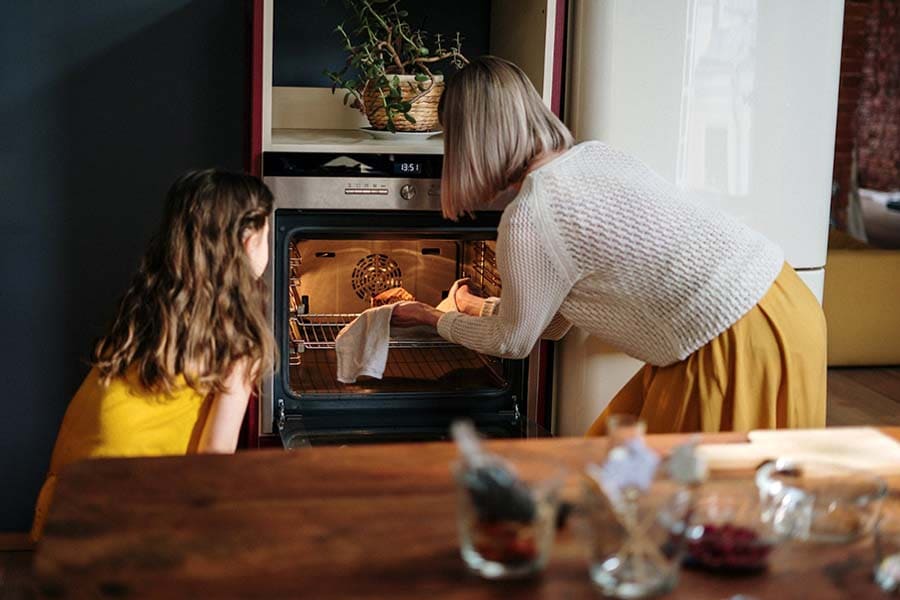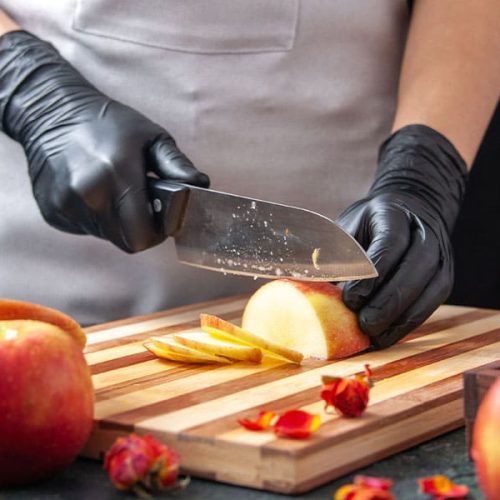Table of Contents
Introduction to Heat-Resistant Gloves
If we have to choose the MAGIC spell for a lovely food it will certainly be BAKING. How amazing it is that we put raw material in an oven and after some time it gives us a lovely sumptuous food, a magic which brings smile and happiness to our lives. This magic happens in our kitchen and the basic element of this magic spell is HEAT and we all know if not handled with safety it can bring injuries to us or our loved ones. To mitigate heat injuries in the kitchen for handling of oven or hot dishes the best answer is Heat-Resistant Gloves for a Safe and Convenient home cooking Experience.
Heat-resistant baking gloves have evolved over time to meet the demands of modern cooking techniques. The present material technology advancements have led to the development of silicone, aramid fiber, and kevlar gloves, which offer good heat resistance and durability to heat exposure.

Photo is curtesy of pexels.com
The Science behind Heat Resistance Gloves
- Materials used in heat-resistant kitchen baking gloves
Heat-resistant gloves are typically made from materials like silicone, aramid fiber, and kevlar. These materials have high heat-resistant properties and are capable of withstanding temperatures up to a certain limit, protecting your hands from burns.
- How heat-resistant gloves provide insulation and protection
Heat-resistant gloves contain insulating layers that create a barrier between your hands and the heat source, preventing heat transfer. Additionally, the materials used in these gloves are designed to withstand high temperatures without melting or causing discomfort.
Types of Heat-Resistant Gloves
To get best value for money, it’s imperative to know the basics of any item we intend to buy and Gloves are no exceptions to this rule. Following information will apprise you on the subject:
- Traditional oven mitts
Traditional oven mitts made from thick fabric offer basic heat resistance and protection. However, they may lack flexibility and dexterity, making it difficult to handle smaller kitchen tools and hot items with precision.
- Silicone gloves
Silicone gloves are a popular choice among home cooks and professional chefs. They are heat-resistant, waterproof, and provide excellent grip due to their textured surface. Additionally, they are easy to clean and can be used for various cooking tasks.
- Aramid fiber gloves
Aramid fiber gloves, such as those made with Nomex or Kevlar, are known for their exceptional heat resistance and durability. They offer reliable protection against high temperatures and are resistant to cuts and punctures. These gloves are ideal for intense cooking situations.
- Kevlar gloves
Kevlar gloves are at the forefront of heat resistance technology. They can withstand extreme temperatures and provide superior protection against cuts, punctures, and abrasions. While primarily used in professional kitchens and industrial settings, Kevlar gloves offer unparalleled safety.
Factors to Consider When Choosing Heat-Resistant Gloves
Once type of gloves selected the next thing which needs your attention is, what factors to consider in a certain type of heat resistant gloves for home cooking.
- Maximum temperature resistance
Before purchasing heat-resistant baking gloves, consider the maximum temperature they can withstand. Different gloves are designed for different temperature ranges, so choose gloves that align with the cooking methods and temperatures you often encounter.
- Comfort and Handiness
Ensure the gloves offer a comfortable fit and allow for dexterity in handling utensils and cookware. Look for gloves with a flexible design and ergonomic features, such as pre-curved fingers, to enhance your comfort and control in the kitchen.
- Cleaning and care instructions
Check the cleaning and care instructions for the gloves. Some gloves are machine washable, while others require hand washing or spot cleaning. Choose gloves that suits with your preferred cleaning method and maintenance routine.
- Size and fit guide
Proper size and fit is crucial for heat-resistant gloves. Gloves that are too loose may compromise your grip, while gloves that are too tight can restrict movement and cause discomfort. Refer to the manufacturer’s size guide and consider measuring your hand to ensure the perfect fit.
Features to Consider in Heat-Resistant Gloves
- Non-slip grip technology
Look for gloves that feature non-slip grip technology, such as textured surfaces or silicone patterns, to ensure a secure hold on hot items and minimize the risk of accidents in the kitchen.
- Extended cuffs for forearm protection
Gloves with extended cuffs offer added protection for your forearms, preventing accidental burns from hot oven racks or splattering oils. Consider gloves with cuffs that reach at least a few inches above the wrist for optimal coverage.
- Water and stain resistance
Heat-resistant gloves that are water and stain resistant are easier to clean and maintain. These gloves can be quickly wiped clean or even washed without compromising their heat-resistant properties.
- Flexible and Pliable materials
Opt for gloves made from flexible and pliable materials, as they allow for better control and manipulation of utensils and cookware. Gloves that offer a good range of motion enable you to perform difficult cooking tasks with ease.
Popular Brands and Models of Heat-Resistant Baking Gloves
For easy selection easy here are some of the best brands to consider for buying heat resistant gloves for home cooks.
- GEEKHOM Heat-Resistant Gloves for Grilling – Best Overall.
- No Cry Heat Resistant Gloves for Grilling – Premium Protection.
- Grill Heat Aid Heat-Resistant Gloves – Most Durable.
- MOAMI Heat-Resistant Gloves for Grilling – Easiest To Clean.
Tips for Maintenance of Heat-Resistant Gloves for Home Cooking
To get maximum out of anything, proper maintenance is the key. Here are some tips to enhance the life of your chosen heat resistant gloves as a home cook
- Store your heat-resistant baking gloves in a cool and dry place to prevent damage from excessive heat or moisture. Avoid folding or creasing the gloves, as this may compromise their insulation capabilities.
- Follow the manufacturer’s cleaning and maintenance instructions to prolong the lifespan of your gloves. Regularly clean them as recommended and inspect for any signs of wear or damage that may affect heat resistance.
- Avoid common pitfalls that lead to glove deterioration
- Avoid exposure of gloves to direct flame, sharp objects, or corrosive substances, as they may weaken the materials and reduce their heat resistance. Additionally, refrain from using heat-resistant gloves for purposes other than cooking to prevent unnecessary wear and tear.

Photo is curtesy of pexels.com
Heat-Resistant Gloves Utility
Heat resistant gloves are considered an essential tool for a home cook because handling of heat without proper gear may result in accident. Your investment in heat resistant gloves as a home cook will make you proud under following situations:
- Grilling with heat-resistant gloves
Heat-resistant gloves are indispensable for grilling enthusiasts. They allow you to handle hot grill grates, flip sizzling steaks, and arrange charcoal with ease and confidence, maximizing both safety and enjoyment during outdoor cooking sessions.
- Handling high-temperature cooking
When working with high-temperature stovetop cooking methods like searing or stir-frying, heat-resistant gloves offer superb protection against intense heat. With these gloves, you can safely handle hot pans, skillets, or woks without the risk of burns.
- Handling hot pots, baking sheets, and oven racks
Heat-resistant baking gloves excel in baking scenarios, where handling hot pots, baking sheets, and oven racks is essential. By using these gloves, you can safely transfer hot items in and out of the oven, ensuring that your culinary creations turn out perfectly.
Heat-Resistant Gloves Utility outside Kitchen
Use of Heat resistant gloves is not restricted to kitchen only. They are useful for outdoor activities, such as camping and barbecuing, where handling open flames and hot objects is common. These gloves provide protection and versatility in various outdoor settings.
Safety Precautions While Using Heat-Resistant Gloves
- Avoiding steam and hot liquid hazards
Heat-resistant gloves protect against dry heat but they are not suitable for handling steam or hot liquids. Thus a careful dealing is required with boiling pots, kettles, or steamers, as the gloves may retain heat and expose you to hazards.
- Using gloves in conjunction with other safety equipment
To maximize safety in the kitchen, consider complementing your heat-resistant gloves with other protective gear, such as oven mitts, aprons, and safety goggles. This combination of safety equipment helps create a formidable barrier against potential accidents.
- Identifying signs of wear and tear for glove replacement
Regularly inspect your heat-resistant baking gloves for any signs of wear and tear, such as holes, fraying, or deteriorating insulation. If you notice compromised heat resistance or damage, it is crucial to replace the gloves promptly to maintain optimal safety in the kitchen.
Frequently Asked Questions
- How long can heat-resistant baking gloves withstand extreme heat?
The duration of heat resistance varies depending on the specific gloves and their maximum temperature rating. However, high-quality heat-resistant baking gloves can generally withstand extreme heat for several seconds to minutes, providing ample protection during typical cooking processes.
- Can heat-resistant gloves protect against cuts and punctures?
While some heat-resistant gloves may offer added protection against cuts and punctures, their primary function is to shield hands from heat. For enhanced cut and puncture resistance, consider gloves specifically designed for such purposes.
- Are heat-resistant gloves suitable for individuals with sensitive skin?
Heat-resistant gloves come in various materials, some of which may cause skin sensitivity in certain individuals. If you have sensitive skin, it is advisable to opt for gloves made from hypoallergenic materials or consult your dermatologist for recommendations.
- Can children use heat-resistant baking gloves?
It is essential to adhere to age-appropriate safety guidelines when allowing children to handle hot objects in the kitchen. While some heat-resistant baking gloves are available in smaller sizes suitable for children, supervision and proper instruction are crucial to ensure their safety.
Conclusion: Embracing the Heat-Resistant Gloves Revolution
Heat-resistant baking gloves provide a safe and convenient cooking experience by offering insulation, protection, and a secure grip. They come in various materials, designs, and sizes to address individual cooking needs and priorities. By understanding the importance of heat-resistant gloves and considering factors like maximum temperature resistance, comfort, and cleaning instructions, you can make an informed decision while shopping gloves. Adopting heat-resistant glove technology will ensures a safer and more enjoyable cooking experience for all.





